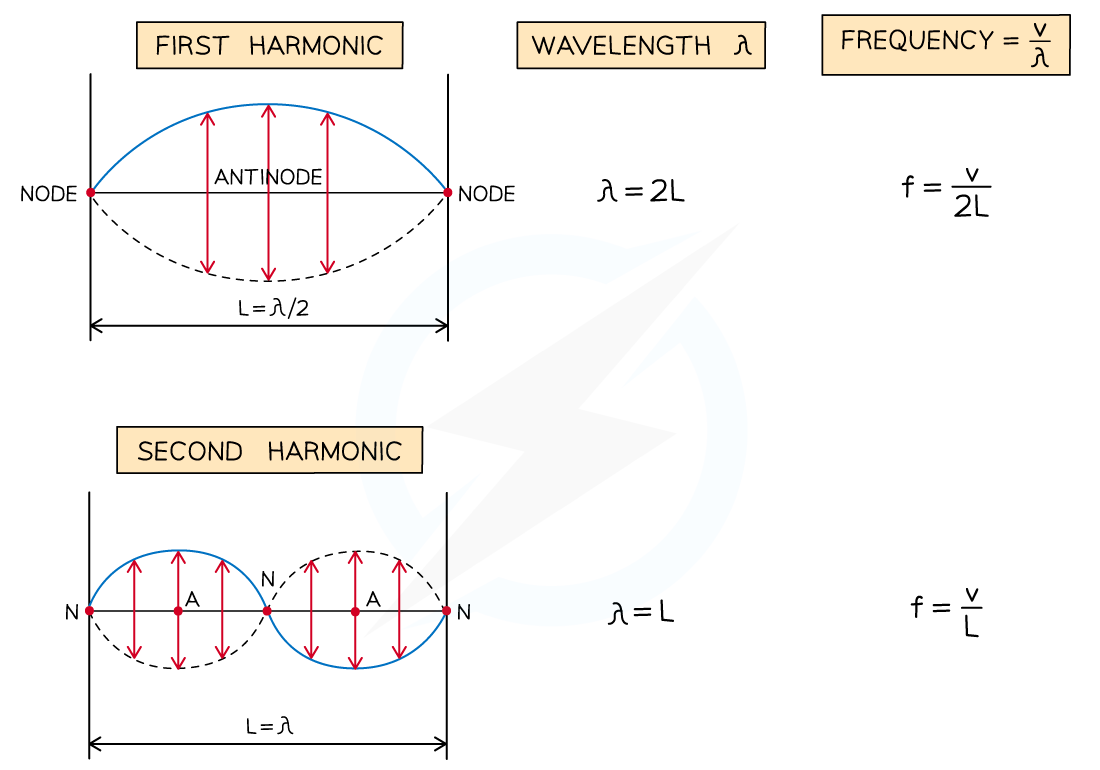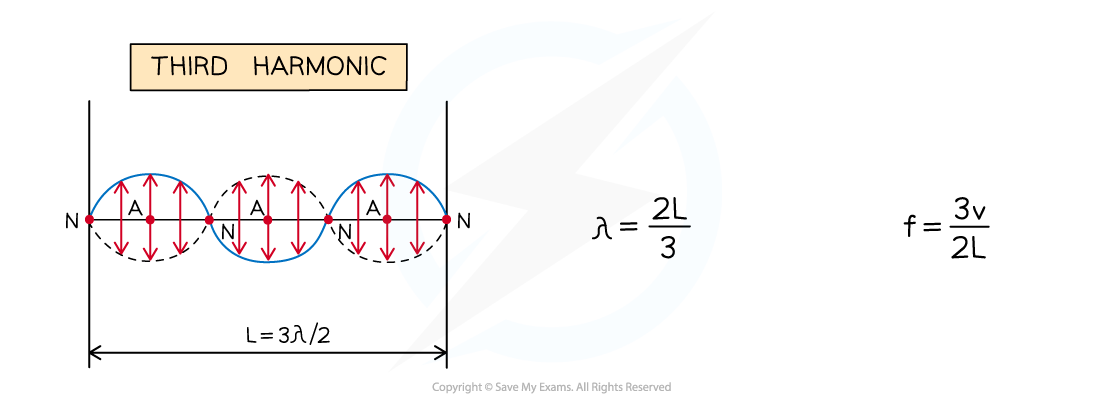Harmonics in Strings & Pipes (DP IB Physics) : Revision Note
Harmonics
Stationary waves can have different wave patterns, known as harmonics
These depend on the frequency of the vibration and the boundary conditions (i.e. fixed and/or free ends)
The harmonics are the only frequencies and wavelengths that will form standing waves on strings or in pipes
Harmonics on Strings
The boundary condition is that both ends are fixed
The simplest wave pattern is a single loop made up of two nodes (i.e. the two fixed ends) and an antinode
This is called the first harmonic
The wavelength of this harmonic is
Using the wave equation, the frequency is
, where v is the wave speed of the travelling waves on the string (i.e. the incident wave and the reflected wave)
As the vibrating frequency increases, more complex patterns arise
The second harmonic has three nodes and two antinodes
The third harmonic has four nodes and three antinodes


Diagram showing the first three harmonics on a stretched string fixed at both ends
The nth harmonic will have (n + 1) nodes and n antinodes
The general expression for the wavelength of the nth harmonic on a string that is fixed at both ends is:
Where:
λn = wavelength in metres (m)
L = length of the string in metres (m)
n = integer number greater than zero - i.e. 1, 2, 3...
Knowing the wavelength λn of the standing wave and the speed v of the travelling waves (i.e. incident and reflected), the natural frequency fn of any harmonic can be calculated using the wave equation v = fλn, so that:
Harmonics in Pipes
The boundary conditions vary, since pipes can have:
two open ends
only one open end
For a pipe that is open at both ends:
The simplest wave pattern is one central node and two antinodes
The second harmonic consists of two nodes and three antinodes
The nth harmonic will have (n + 1) antinodes and n nodes
The expression for the wavelength of the nth harmonic in a pipe of length L is the same as that given above for nth harmonic on a string

Diagram showing the first five harmonics in a pipe open at both ends
For a pipe that is open at one end:
The lowest harmonic is a "half-loop" with one node and one antinode
The next possible harmonic will have two nodes and two antinodes
This is the third harmonic, not the second one
Since only odd harmonics can exist under this boundary condition

Diagram showing the first three possible harmonics in a pipe open at one end. Only the odd harmonics can form in this case
The expression for the wavelength of the nth harmonic in a pipe of length L is:
Where this time, n is an odd number - i.e. 1, 3, 5...
Under both boundary conditions, the natural frequencies are once again calculated from the wavelength of the standing wave and the speed v of the travelling waves using the wave equation
Worked Example
Transverse waves travel along a stretched wire 100 cm long. The speed of the waves is 250 m s–1.
Determine the maximum harmonic detectable by a person who can hear up to 15 kHz.
Answer:
Step 1: Write down the known quantities
Length of the wire, L = 100 cm = 1.00 m
Speed of the waves, v = 250 m s–1
Maximum frequency of human hearing, fn = 15 kHz = 15 000 Hz
Step 2: Write down the equation for the frequency of the nth harmonic and rearrange for n
Step 3: Substitute the numbers into the above equation
The person can hear up to the 120th harmonic
Examiner Tips and Tricks
Before carrying out any calculation on standing waves, you should look carefully at the boundary conditions, since these will determine the wavelengths and natural frequencies of the harmonics.
The expressions for the wavelength of the nth harmonic on strings fixed at both ends (or in pipes open at both ends) and in pipes open at one end are not given in the data booklet and you must be able to recall them to make calculations easier.
Remember that n can take any integer value greater than zero in the case of standing waves on strings and in pipes open at both ends. For pipes open at one end, instead, n can only be an odd integer.

You've read 0 of your 5 free revision notes this week
Sign up now. It’s free!
Did this page help you?
